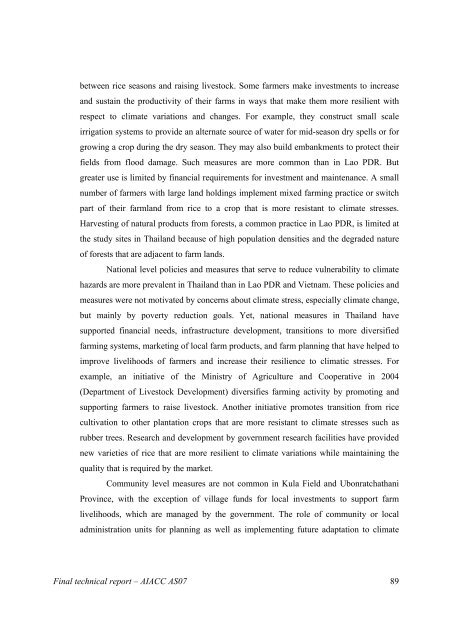Final Technical Report - weADAPT
Final Technical Report - weADAPT
Final Technical Report - weADAPT
- No tags were found...
You also want an ePaper? Increase the reach of your titles
YUMPU automatically turns print PDFs into web optimized ePapers that Google loves.
etween rice seasons and raising livestock. Some farmers make investments to increase<br />
and sustain the productivity of their farms in ways that make them more resilient with<br />
respect to climate variations and changes. For example, they construct small scale<br />
irrigation systems to provide an alternate source of water for mid-season dry spells or for<br />
growing a crop during the dry season. They may also build embankments to protect their<br />
fields from flood damage. Such measures are more common than in Lao PDR. But<br />
greater use is limited by financial requirements for investment and maintenance. A small<br />
number of farmers with large land holdings implement mixed farming practice or switch<br />
part of their farmland from rice to a crop that is more resistant to climate stresses.<br />
Harvesting of natural products from forests, a common practice in Lao PDR, is limited at<br />
the study sites in Thailand because of high population densities and the degraded nature<br />
of forests that are adjacent to farm lands.<br />
National level policies and measures that serve to reduce vulnerability to climate<br />
hazards are more prevalent in Thailand than in Lao PDR and Vietnam. These policies and<br />
measures were not motivated by concerns about climate stress, especially climate change,<br />
but mainly by poverty reduction goals. Yet, national measures in Thailand have<br />
supported financial needs, infrastructure development, transitions to more diversified<br />
farming systems, marketing of local farm products, and farm planning that have helped to<br />
improve livelihoods of farmers and increase their resilience to climatic stresses. For<br />
example, an initiative of the Ministry of Agriculture and Cooperative in 2004<br />
(Department of Livestock Development) diversifies farming activity by promoting and<br />
supporting farmers to raise livestock. Another initiative promotes transition from rice<br />
cultivation to other plantation crops that are more resistant to climate stresses such as<br />
rubber trees. Research and development by government research facilities have provided<br />
new varieties of rice that are more resilient to climate variations while maintaining the<br />
quality that is required by the market.<br />
Community level measures are not common in Kula Field and Ubonratchathani<br />
Province, with the exception of village funds for local investments to support farm<br />
livelihoods, which are managed by the government. The role of community or local<br />
administration units for planning as well as implementing future adaptation to climate<br />
<strong>Final</strong> technical report – AIACC AS07 89
















